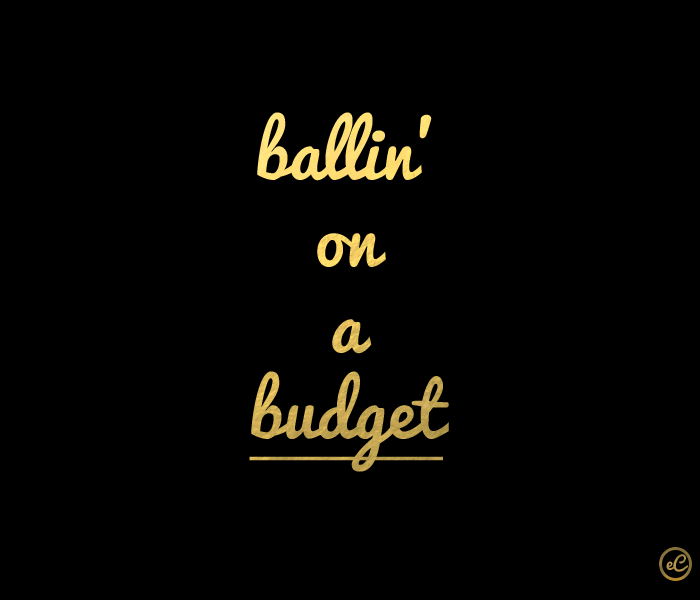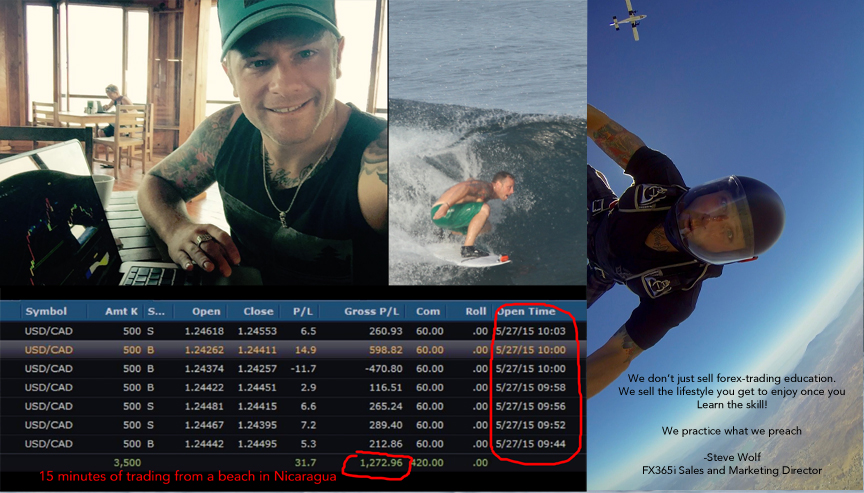
by Steve Wolf | Oct 13, 2016 | Business, Lifestyle, Money
I wrote a previous blog on money management where I shared some tips on how to identify where you are wasting money and then gave my own personal formula (via an downloadable excel spreadsheet found here) the gauge all of your spending. If you are coming from that blog, then you are in the right place. If you are just looking at this blog for the first time, it may be prudent to go back and check out the previous one I wrote or at least download the excel spreadsheet because you will need it for the next step.
Step 2 – Formulating a simple budget that you will actually follow.
It was told to me early on in life by a very wealthy mentor of mine who I respect dearly that if I couldn’t manage $1, then I couldn’t manage $1 Million dollars. This is so true, I meet people all the time who’s personal finances are garbage even when they are making great money in their career.
It all comes down to money management and budgeting. Again, this is another common thread among all wealthy people I have ever met; they all have a budget based on a formula that uses money as a tool never spending it emotionally. Here is what to do.
Take that excel spreadsheet you just downloaded. (or get it here)
The idea here is very simple. Manage any and all money that you get. EVERY SINGLE CENT! If you know what your monthly income is, it becomes very easy to budget, if you are like me and get paid in lump sums sporadically then disciplining yourself to a system like this is crucial!
Ok so here is how it works: For every dollar I take in, it gets split up and put in to different bank accounts. Each bank account represents a different aspect that I am saving for. In my case I have 8 Bank accounts. I explain what I use them for and the benefits.
- Wells Fargo Checking / Savings account – This account is used for daily spending, and paying bills. Think of it as your most active account, all money is deposited here before it goes to other accounts.
For daily spending and bill payment, I like Wells Fargo. The important thing to remember here is to bank with a bank that is convenient to for you with lots of locations and low fees across the board. As of right now, I pay NO FEES with Wells. I think B of A is the worst, and Chase Bank is in the middle when it comes to big banks.
- Discover Bank # 1 – Taxes (This is where I said aside money for taxes every year)
- Discover Bank # 2 – Emergency Fund account (Save for a rainy day)
- Discover Bank # 3 – Long Term Savings (Use for large purchases like a house or car etc.)
I use Discover bank because they give you the highest rate of return for a savings account. 0.95% to be exact and…
- No minimum deposits
- No Account Fees
- Open as many accounts as you want
- Capital One 360 # 1 – Annual Expenses account (Money set aside for annual expenses like car insurance, property tax etc.)
- Capital One 360 # 2 – Vacation Fund (Saved money for Vacations)
I use Capital One 360 because they pay a pretty good rate of return on money in savings and my account doubles over as my top pick for a travel debit card that has
- No minimum deposits
- No Account Fees
- Open as many accounts as you want
- NO foreign transaction fees
- No ATM banking fees.
(If you are interested in opening up a Capital1 360 Account and want $20 for free just for doing so, click this link.)
- Wealthfront Account – Managed Portfolio Long term investing account
(Click here to learn about wealth front and why I recommend them. Clicking this link will get your first$15,000 managed for FREE!!)
- FXCM Account – This is my active foreign currency trading account as I trade currencies daily. If your are interested in learning how to trade I wrote a blog about it here, otherwise, dedicate the 5% I am setting aside in this account to some other find or investment.
Now take some time to look it over the excel spreadsheet. If you need to open a couple accounts, don’t worry, this can literally be accomplished in an hour, follow the links above to use my recommendations, or feel free to open up accounts where your want to.
Keep in mind that I am a 1099 independent contractor that means I pay my own income taxes each year. If you are a W-2 employee, then you can zero out the taxes line because your taxes are collected before you get paid. Personally I set aside 18%-20% a year for myself, you may pay less or more depending on how much you make and what your tax liabilities look like.
- Enter all of your monthly and annual expenses. (You will see some numbers starting to populate)
- Replace my bank accounts with your banks and match them closely as possible, meaning if you have a normal B of A or Chase Checking and savings account, that should be your main account at the top. If you have an E*TRADE, Schwab or IRA, replace my Wealthfront account with yours etc.
- If there are some areas where you will need to set up new bank account, leave them blank for now
- Now enter in your monthly income at the top in the yellow (total monthly Colum)
- By now you should see some of the boxes populating. I will explain what’s happening here
The Breakdown.
Ok by now you probably have a good idea of what I am driving at here, but I will explain anyway. This formula is partitioning all of your income into different savings columns to give you a well rounded and financially savvy money management system.
The breakdown as seen in my excel sheet looks like this.
- I earn $100
- $20 (20%) is saved for taxes and taken right off the top (Skip step if you are a W-2 employee)
- Now I have $80 Left
- $40 (50%) Goes to my living expenses, i.e. rent, mortgage, car payment, food, gas etc.
- $10 (10%) – To the emergency fund, after all shit happens.
- $10 (10%) – Long-term savings fund. This could be for a future large purchase like a car or house down payment.
- $8 (8%) – Annual Expenses Account – Like car registration or medical/life insurance. Things that get paid once per year
- $7 (7%) – Vacation Fund – To broke to take a vacation, do this for a year, and I promise you that you will have enough to take a vacay!
- $10 (10%) – Long-term investment account – YOU NEVER TOUCH THIS MONEY! This is for your retirement. You may be thinking I’m way to young to start saving for retirement, but the difference between starting this habit at 20 years old compared to 30 years old will mean a difference of hundreds, yes I said hundreds of thousands by the time your retire. So don’t fuck around with this one, set the 10% aside and forget about it.
- $5 (5%) – For me it goes to an active trading account that I personally trade. If you have no desire to learn how to actively trade, you can simply put this money towards some other kind of investment short term to medium term, but this money is not for bullshit, it’s money set aside for short-Medium term investments with a bigger return on the short side.
Conclusion
This whole idea was adopted after first reading the age old book The Richest Man in Babylon. When done correctly you will learn to pay yourself first and then save and invest the rest of it leaving a little hear and there for having a good quality of life.
My parents generation saved about 20%-30% of there income on average. My generation saves a measly 5%-10% and knowing that we are going to need a least a cool million to retire on (4 times as much as my parents will need) we need to get on this today. There is literally no time to waste.
Again, if you are in debt, or not making a lot of money, apply this formula anyway. Rework the numbers to make them fit your situation. If you are in some serious debt, check out my blog on &^%&^%&*^%&* if you are just not making that much or spend money stupidly, then I challenge you to try this for 90 days. If after 90 days you don’t feel like you have a better handle on your finances and that you are heading in the right direction, comment here and I will jump out of an airplane to promote what ever you want me to.
Money is a tool. It is only emotional when you don’t have enough of it. It controls you, or you control it, simple as that.
****And as a bonus, if you are still not convinced, Acorns is a nifty little app that allows you to invest pocket change from rounded up expenditure in to the market as a long term investment. Follow this link to check it out and get $5 for opening an account.
Did you mis part 1 of this blog? Read it here!

by Steve Wolf | Jun 28, 2016 | Business, Money, Travel
It is not everyday that you really get to feel all of your hard work pay off. When I started currency trading 3 years ago, it was hard. There was a learning curve, and at times it seemed daunting and elusive to actually be successful at trading.
I really believe that when attempting anything new, there is going to be a period of time where you just suck at it. When you are a person who really likes to win, it can be difficult to attempt new things. The trick is that you simply need to accept the fact that you are a rookie, a noob, a kook or whatever and that you are not going to be killing it one month out of the gate.
Trading currencies has been a game changer for me. Coming from the sales and marketing world, investing in general seemed to be for brainiac types who were really good at numbers. I knew that I could always make money in a situation where there was something to sell, but could i have the same success as an investor, or as a FOREX Trader?
When I first found the Forex market I was vacationing in Bali Indonesia on a surf trip. On a day where there wasn’t any surf to be had, I started looking for ways to make money from a laptop…. (Watch the video, it will explain the rest so I can get on with my story)
Once I found the market and made my first couple hundred dollars before the sun came up one random morning, I was hooked! Unfortunately I never took in to consideration that in order to win at trading, you are going to take losses, and I was a guy who didn’t like to lose. I proceeded down a losing spiral of lost profits and nearly decimated my entire trading account in less then a months time.
I took a break from trading and was feeling pretty beat up by the market. Losing can really screw with you when catch a bad streak like I did. I was not prepared for the emotional turmoil that ensued. Unlike anything I had attempted before, currency trading required me do adopt a high level of emotional intelligence in order to be successful at it. So I got back up, dusted myself off, and got back to it.
I went back to the school where I had originally learned how to trade. I went through the course again with no expectations and a new willingness to learn.
The curriculum didn’t change, my perspective did. This time around, I was a lot more humble. After all I got my ass kicked. After putting in 6 months of hard work in, I starting to see some positive results in the form of substantial equity growth in my account. I was ready to take the show on the road, and see if I could really do this from anywhere in the world.
I headed down to Nicaragua with my girlfriend with 3 goals in mind:
- Propose to my girlfriend
- Surf some big waves
- Pay for the whole trip currency trading from my laptop
I scored big time. The surf was macking, and I was pretty sure my girlfriend was going to say yes to marrying me. I was just waiting for the right moment to propose. I started doing my pre-sessions & technical analysis on the market looking for some trades one morning, and then just like that, a couple trade set ups presented themselves and I pulled the trigger!
— I was sitting in a youth hostel using their shotty wifi and hoping to God that the internet did not go out before I closed my trades. With in 15 minutes of trading I managed to pull 7 scalped trades netting me $1,272.96 after commissions. —
I closed my laptop, ordered an iced coffee and just sat for 10 minutes staring at the ocean and feeling like I had just pulled off a huge victory! I soaked it up, I proved  that not only could I trade, but I could do it from a shitty hostel with bad wifi in Central America. Later that evening, I asked my girlfriend to marry me and she said yes.
that not only could I trade, but I could do it from a shitty hostel with bad wifi in Central America. Later that evening, I asked my girlfriend to marry me and she said yes.
So I got 2 out of 3 of my goals done. Even though $1,300 was not enough to cover the entire trip, I felt like $1,300 for 15 minutes of my time was well worth taking the rest of the trip for myself and to celebrate my new engagement. Besides, the surf was macking remember!
The moral of the story is that If you put your mind to something and stick with it, you can do it. The path to success is not linear, but it follows a trend!
If you want to know more about how you can become a currency trader and make profits in the market from a lap top anywhere in the world click the logo below and find out more about the FX365 Institute!


by Steve Wolf | Jun 7, 2016 | Business, Lifestyle, Travel
In my last blog I wrote about the Joy’s and freedoms of working remotely. If you missed it, read it here! This will give you a little better context of what I am writing about in this 5-Step process to finding the perfect remote job to keep you traveling and experiencing the world all while making money from your lap top.
Here is my 5-Step Process.
1 – Find a job, skill, or way that you can actually do that will produce income with out you physically needing to be there.
This is going to be your most difficult task. You may be saying to yourself “well I am a doctor, how could I possibly practice medicine from a laptop?” Well this comes down to how resourceful you want to be. My dad is doctor, a Podiatrist to be exact and he has been looking into what is know as “tele-medicine” which is basically on call and on demand video conferencing from doctors to patients. Say you have a foot problem, you go on the site, set an appointment, my dad would accept it, you are instantly connected, he gives your advice and recommendations and your done. The system charges the patients credit card and they go on their way. Booya, there is a way a doctor can work 100% remotely. You may be surprised what you find if you really start thinking of all the different ways you could monetize your skill sets right from a computer from anywhere in the world, don’t worry, we will get to that in number 2.
2. Get really good with technology.
If you are going to have any chance at being an entrepreneur on the road, then you are going to have to get really good with leveraging technology and automation. What do I mean by this. Well put it this way, I can pretty much run all of my business from my iPhone. Everything from a CRM to a VOIP telephone system that allows me to communicate effortlessly through WIFI any where in the world. This means that if you are planning on getting in to a business that has to ship “real” goods and logistics as well as a customer service dept. will be necessary, than you are going to have your work cut out for you. I am not saying that it is impossible, just going to take a couple extra steps of strategic planning and utilization of technology that automates the process.
3. Simple is better.
A good business is not necessarily a complex business. I would consider a solid business to be one that is profitable, allows you to live the life you desire and takes care of it’s employees and it’s customers. Some of the best businesses that I know of were born out of the simplest ideas or needs by a consumer. Take for example the work we do at the FX365 Institute, we teach people how to trade currencies all over the world from office in San Diego. We have students in 20 U.S. States and 4 countries that take our course 100% remotely and learn a skill set that allows them to make money in the foreign currencies market anywhere in the world from a laptop. Don’t over complicate this part. The less you need to run your business, the better off you will be.
4.How much do you really need to make?
My favorite part of explaining these concepts to people is conveying the fact that a business only needs to make you a “enough” money in order for it to change your life. If you added up all of your expenses annually, and then added in the costs to live in another country or to travel a couple months out of the year I think you will be surprised to find that you don’t need to make $300K per year to achieve your goals. In fact, I have been able to travel about 2 months out of every year for the past decade making around $100k per year. The best part is that I only really needed about $60K to sustain so any extra money that I make on top of my yearly nut goes in to savings and investments. This allows me to stay diversified, active in the markets using online portfolio managers, and open to new ideas and businesses while I can keep the quality of life I have come to enjoy. The point is to make enough and then a little more. You don’t need to be a millionaire to pull this off.
5. Multiple Streams of Income remotely
I know you have heard this one before, but maybe not through the lens of doing it remotely. Every book I have read on this topic is about real estate and multiple businesses that would require you to physically be somewhere to manage those streams. When you start to venture down the road of working remotely you start looking at businesses in a whole new light.
I have come up with a couple of questions that I use to test the remote possibilities of a business. These days, if they do not get passed these questions with a yes, then I am probably going a different direction. I wrote two articles that may give you more context when it comes to working remotely, follow the links below to check them out:

by Steve Wolf | Jun 3, 2016 | Business, Lifestyle, Travel
Does your Remote business pass the litmus test? Could you actually leave the country for weeks or months at a time and still count on the business to grow on its own and produce income.
In this article I am going to share with you some of the most important questions that you should be asking yourself to avoid a career that is going to keep you chained to your desk.
When I am approached with a business or come up with an idea, I ask myself these following questions to help me decide if I should even consider pursing the business. I wrote a blog recently about The Joys of working remotely and also my 5-Step process to finding the perfect career where you can travel the world and work from a laptop.
I have come up with a couple of questions that I use to test the remote possibilities of a business. These days, if they do not get passed these questions with a yes, then I am probably going to go a different direction. I wrote two articles that may give you more context when it comes to working remotely.
Now for the smell test questions:
1. If I spent a year building this business and I left the country for 2-4 weeks with out being able to call back or answer any emails would it still be standing when I go home?
This may take some introspection and some deep thinking about what the business is, who it would involve and what you would need to figure out to get all of the pieces together. This type of think and evaluation will become paramount when assessing situations for your business in the future, so play the tape out and visualise as best as you can where you would see yourself and the business in a year or two.
2. Is this a business I can run myself, or will I need to hire or contract out work to properly run it and if I do, will I be able to effectively manage the team remotely?
If you can do it on your own, great, do it! Unfortunately most enterprises even small ones will need to depend on others to accomplish what ever it is your business will do or provide for people. The question you need to concern yourself with is can you effectively manage then from a far or set the business up in a way where employees or partners can or would be self serving and motivated to accomplish tasks day to day to keep the company running smoothly.
3. On a scale from 0%-100% how much of the business can I automate?
(0%-60% is no good / 60%-80% is ok / 80%-100% is ideal). Automation is going to be key for you to managing efficiently from a far. It will allow you to batch work and delegate important work properly. Also it really allows you to step away from the business or parts of the business for days or weeks at a time and then come back to spot check at a later date. Most importantly automation usually takes the place of what human used to do and will allow you to perform more high value activities for the business.
4. Will it make me enough money to give me the life I desire to have and if so how long will it take to get me to that point? 60 Days? 6 months? A year?
For more on this topic check out my blog I wrote on Time vs. Money! This will really put this step in to perspective for you.
5. Pros and cons list – Now for the final step, write down all of the great things about how the business is going to get you what you want out of it. Examples could be things like “90% automation” or “allows me to travel 6 months per year” etc and then do the same for all of the potentially negative elements about the business. Make sure to be real with yourself here. Don’t sugar coat this part.
Once you have completed all of these steps, then you will have a solid understanding about what you could potentially be getting involved in. I can’t stress the importance of the exercises!
Working as a management consultant for a number of years I have a keen ability to understand what is going to make a business succeed or fail. Unfortunately most folks don’t even think about these things when starting a business. Instead they get excited about the idea, or one aspect of the new business and run with it throwing caution to the wind and ignoring or simply not flushing out the idea and all the pit falls that would ensue first.
Be smart, be savvy and get the business that will give you the life you desire but don’t ever be afraid to give your idea a litmus test! It will save you time, money and heartache in the future. These simple actions will keep you on the right track helping you to avoid a business or an idea that will stand in the way of a more well suited business or opportunity that will give you everything you need.



 that not only could I trade, but I could do it from a shitty hostel with bad wifi in Central America. Later that evening, I asked my girlfriend to marry me and she said yes.
that not only could I trade, but I could do it from a shitty hostel with bad wifi in Central America. Later that evening, I asked my girlfriend to marry me and she said yes.

